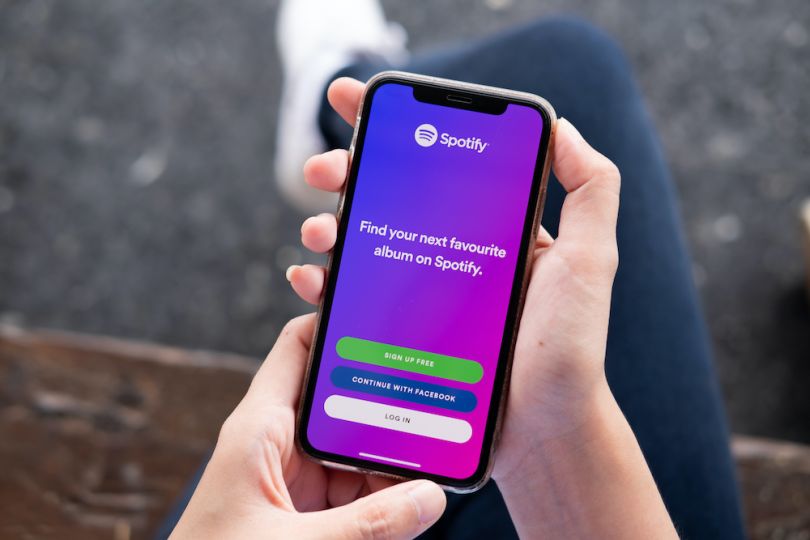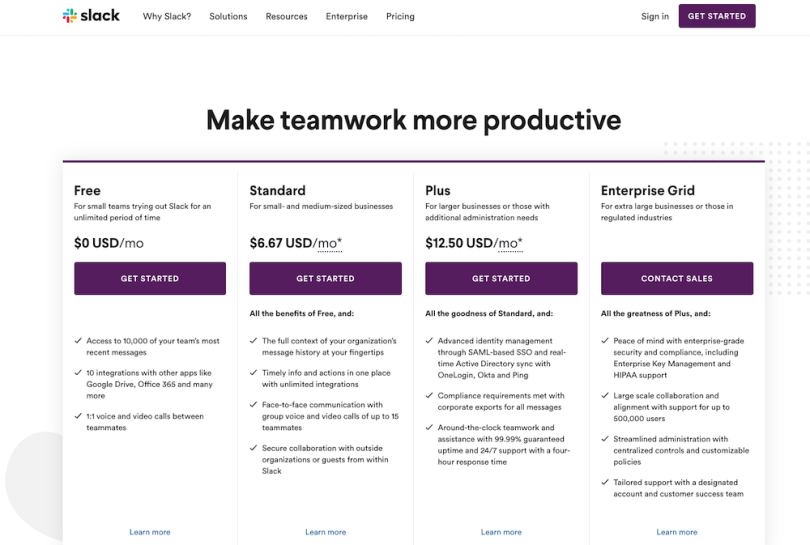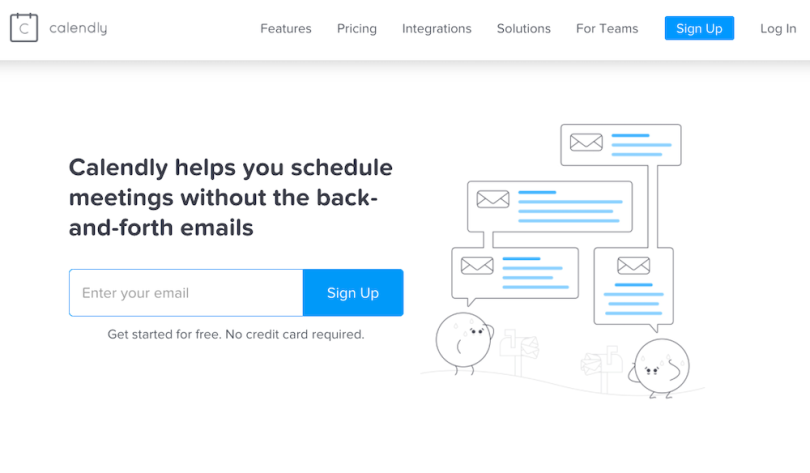Some of the world’s most successful software startups rely on a strategy called product-led growth.
Take Slack, Zoom and Dropbox. You don’t have to talk to a salesperson before using their products. Or even pay. You just go to their sites, sign up and get started. Within minutes, you’re setting up a workspace, making a video call or sharing a large file. And it’s easy to upgrade on your own if you want to. This ease of use is why millions of people try them.
Product-led growth emerged because consumer apps spoiled us. Many of them offer free, frictionless experiences, easy enough for anyone to use on their own. Now, we expect much of the same from the software we use for work.
What Is Product-Led Growth?
“The way people buy is changing,” Ashton Rankin, product manager at Vidyard, told Built In.
A decade ago, when a company wanted to buy Vidyard’s video-sharing product, an executive (usually a CMO) would request a demo, talk to a salesperson and then make a purchase decision.
Today, the process is more like this: Someone hears about Vidyard’s product, goes to its website and tries out the free version. If they like it, they tell their coworkers about it and, eventually, their company upgrades to a paid version.
Product-led growth takes advantage of this new landscape.

Offering a Great Product Experience
The cornerstone of product-led growth is a great product experience — one that is typically free, self-serve and designed to deliver value quickly. Some will have a virality component built in.
1. Free
People love free stuff, which, in a product-led context, usually takes the form of a freemium version or a free trial. Freemium means the customer can access some (but not all) of the product’s features in what is often a streamlined, stripped-down version of the product. They can pay to upgrade and unlock additional features. A free trial refers to a time period during which the customer can access the full product. After their time runs out, they have to pay to keep using it.
2. Self-Serve
A self-serve product is one the customer can easily figure out how to use on their own. The sign-up, onboarding and upgrading or cancellation processes are all clear and intuitive. The customer may be sent automated onboarding emails, or get in-app pop-ups providing tips. But a call with a customer success manager isn’t necessary. The customer is given the keys to the product right away.
3. Short Time to Value
The customer gets value from the product almost immediately (and certainly before they are ever asked to pay for it). Maybe it’s creating an expense report with Expensify, or scheduling a meeting in Calendly. Whatever the case, the customer should experience an aha! moment shortly after signing up and starting to use the product.
4. Viral
It’s not necessary for a great product experience to have a viral component. But strong word of mouth and built-in network effects certainly help for scaling it (and making it fun). An invitation system is how Slack takes over businesses from the bottom-up.
A free, self-serve (and potentially viral) product that quickly delivers value to users has the potential to grow a massive user base. Some users will eventually churn, and a lot will stay on the free plan. But some of them will upgrade to a paid, premium version of the product to get even more value out of it. This gives the company recurring revenue.

Becoming a Product-Led Company
A company can’t just slap a free trial on its product and call itself product-led. An organizational shift has to take place — one that aligns each team around the product.
In Product-Led Growth, Wes Bush writes that, in a product-led business, each team leverages the product to hit its goals.
The marketing team uses the product as a lead magnet. The sales team uses product usage data to qualify prospects. The customer success team asks how the product can improve users’ lives without their help. And the engineering team builds a product that accelerates time to value.
Departments aren’t replaced by the product. But they are, as the name suggests, led by it.
Product-Led vs. Sales-Led
At a product-led company, the product itself onboards the user, teaches them how to use it and helps them upgrade or cancel.
In a sales-led company, the user has to interact with people before they can interact with the product. They usually talk to sales and customer success before they start seeing the value of their purchase.
Neither model is necessarily right or wrong. It depends on the product.
In Product-Led Growth, Bush lists several factors that inform whether a company should adopt a product-led or a sales-led approach.
Product-led might be a good idea if:
- The product is intuitive and delivers value quickly.
- The product is meant for small and medium-sized businesses.
- The total addressable market is large, and competition is fierce.
A product-led company is superior to a sales-led model in customer acquisition. It can scale up really quickly and amass a large user base. Offering a free version widens the top of the funnel; many people come through the door to try it out. And because the product is self-serve, the company can usually operate with a smaller team, which lowers costs.
Sales-led might be a good idea if:
- The product is complex to use.
- The product is for enterprise customers.
- The product is going after a niche, uncontested market.
Some products come with a steep learning curve, or are designed to solve complex needs at the enterprise level. In those cases, it wouldn’t be wise to drop a customer into a self-serve experience; it would only confuse them. A sales-led, request-a-demo, white-glove approach might make more sense.
Should Sales Be Worried?
Atlassian, a pioneer of product-led growth, sold hundreds of millions of dollars worth of software without a single salesperson on its payroll. So in a world where product-led growth is trending, should salespeople be worried about going extinct?
Eric Keating doesn’t think so. As vice president of marketing at Appcues and founding member of the Product-Led Growth Collective, he understands the concern. But ultimately, he said, product-led growth won’t wipe out sales jobs — it will transform them.
“A sales team can actually be very helpful in product-led companies,” Keating told Built In, adding that the roles are evolving.
Salespeople at Appcues take a consultative posture, he said, and operate more like a hybrid of customer support and customer success than a traditional sales team.
“It’s adapting to the consumer expectation where [people] don’t want to be sold,” Keating said. But they are open to getting “help from your team, be coached along the way.”
“A sales team can be very helpful in product-led companies.”
In the product-led paradigm, sales interacts with someone who’s already using the product. So there’s less pressure to sell a prospect something they may not want, and the conversation becomes much easier than a cold call.
At Vidyard, users are “coming to the conversation not necessarily needing to be convinced by our team,” Rankin, the product manager, said.
The sales team helps customers think through if upgrading to a business or enterprise package would give them more value than the freemium version.
“They already know Vidyard is working for them because they’re using it for free,” Rankin said. “They just want to know how to take it a step further.”

Deciding Between Freemium and Free Trial
If a company decides to become product-led instead of sales-led, its next big decision is whether to offer a freemium product or a free trial.
Free Trial
A free trial approach gives users the full product experience for a limited amount of time (typically seven, 14 or 30 days). After that, the user has to pay to keep it.
Free trials have the ability to showcase everything the product can do. The user comes away with a clearer sense of what the full, paid experience of the product looks like. So if the product has a little bit more complexity, nuance or specialization to it, a free trial might make more sense than a freemium version with limited functionality.
Free trials also speed up the sales process. At the end of the trial period, the user either churns or converts; there is no option to linger as a free, casual user.
Some companies ask users to enter their credit card information in order to sign up for free trials. This creates fewer, but more qualified, leads. The conversion rates for free trials that ask for a credit card up front are much higher than freemium.
In some product-led circles, though, free trials seem to be less popular than freemium.
“One of the arguments against free trial is it doesn’t give the users a chance to fall in love with the product,” Jessica Meher, co-founder and chief executive officer of Wonderment, told Built In. “So I think if you’re going to have a free trial, experiment with trial lengths.”
Freemium
A freemium approach offers a product that has a limited number of features. It gives users basic functionality, but keeps the bells and whistles locked behind a paywall. There is no time constraint.
Freemium is the preferred route for companies trying to grow the largest user base possible. Because there’s no barrier to signing up, many people do. A freemium product is more shareable, and conducive to viral growth, than a free trial.
“If your goal as a business is to build up a very large base of users, freemium can be very good at that,” Keating said. “You’re going to get more people in the door, because they know they’re never going to hit a time-based wall.”
“If your goal is to build up a large user base, freemium can be very good at that.”
Freemium also works well if the product offers a simple, streamlined alternative to existing products that are superior but more expensive or harder to use.
Wes Bush provides the example of Canva. It’s not nearly as powerful a graphic-design tool as Adobe Photoshop. But it provides people a free, quick and easy way to create custom graphics. (Canva rode its freemium model to a $6 billion valuation.)
One downside of the freemium model is that it can easily create a situation where there are lots of free users and very few paying customers. Conversion rates for freemium models are notoriously low.
Done right, a freemium product should deliver real value — but not so much value that it makes upgrading for a premium version irrelevant.
As serial entrepreneur Rob Walling famously said: “Freemium is like a Samurai sword: unless you’re a master at using it, you can cut your arm off.”

Product-Led Growth Requires a Culture of Experimentation
Regardless of whether a product-led company goes for freemium or free trials, it has to keep a close eye on the numbers, and learn how to convert its free users into buyers — and adjust tactics accordingly.
“In order to do product-led growth really well, you need to have good data,” Meher said. She worked for several product-led companies, like InVision and Notarize, before co-founding her own.
She said that product-led companies analyze several data points, such as how often users interact with the product, where they encounter friction and get hung up on it, when they churn, when they convert, what features they pay for.
All of this data gives the company ideas for how to iterate on the product — what features to add, tweak, get rid of; what prices to adjust. Things change often.
“In order to do product-led growth well, you need good data.”
It is common, then, to see successful product-led companies embrace a culture of experimentation. By virtue of always presenting a free option, product-led is a little bit risky. Executives and investors alike need to buy in.
“You don’t want to always be trying to convince someone that the path you’re on is the right one,” Rankin said.
Her company, Vidyard, started out with a sales-led model, offering only paid products. But in the past couple of years, it transitioned to a product-led model and offers a free, self-serve product. Doing so has grown its user base.
“What you need,” she said, “is the company to be bought into what the end-goal is, and why you’re doing it.”




